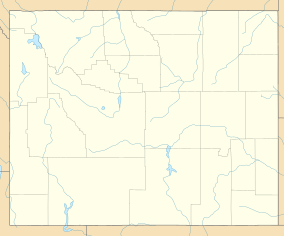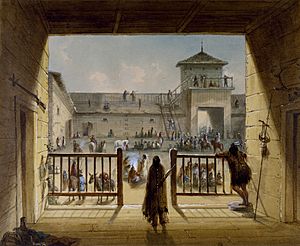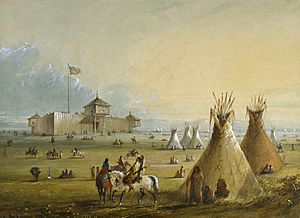Fort Laramie National Historic Site facts for kids
Quick facts for kids Fort Laramie National Historic Site |
|
|---|---|
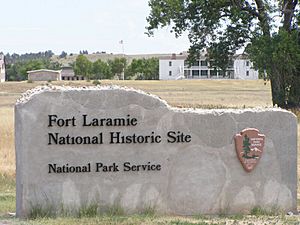 |
|
| Location | Goshen County, Wyoming, USA |
| Nearest city | Torrington, Wyoming |
| Area | 833 acres (337 ha) |
| Established | March 4, 1931 |
| Visitors | 46,455 (in 2005) |
| Governing body | National Park Service |
| Website | Fort Laramie National Historic Site |
|
Fort Laramie National Historic Site
|
|
| Nearest city | Fort Laramie, Wyoming |
| Area | 536 acres (217 ha) |
| Built | 1834 |
| Built by | US Army Corps of Engineers |
| Architect | US Army Corps of Engineers |
| Architectural style | Lime grout construction |
| NRHP reference No. | 66000755 |
| Added to NRHP | October 15, 1966 |
Fort Laramie was a very important place in the 1800s. It started as a trading post where people bought and sold goods, especially animal furs. Later, it became a place for important meetings between the US government and Native American tribes. Finally, it was a military base for the United States Army.
This historic site is located where the Laramie River meets the North Platte River in what is now Wyoming. It was a key stop for many travelers heading west on famous routes like the Oregon Trail. Today, the remaining buildings are protected as the Fort Laramie National Historic Site by the National Park Service.
Contents
A Look Back: Fort Laramie's Story
How Fort Laramie Got Its Name
The area around the fort is named after a trapper named Jacques La Ramee. He lived and trapped furs here around 1815. Sadly, he disappeared in 1819 or 1820 and was never seen again. The river was named "Laramie" in his honor. Later, the nearby mountains, the fort, and even towns like Laramie, Wyoming also took his name.
From Fur Trading to a Busy Stop
The very first fort was built in 1834 by William Sublette and Robert Campbell. It was called Fort William. This was a time when trading animal furs was a big business. The fort was bought and sold a few times by different fur traders.
The fort was built in a great spot. It was near two rivers, which made it easy for travelers to get water. It was also a good place to cross the North Platte River. This made it a perfect stopping point for people traveling west. It was about a quarter of the way to places like California or Oregon on the Oregon Trail.
In 1841, the American Fur Company bought the fort and changed its name to Fort John. This new fort was made of adobe bricks. By the late 1840s, more and more people were moving west. The US Army realized how important Fort John was.
In 1849, the US Army bought the fort for $4,000. They wanted to protect the many wagon trains of settlers heading west. These travelers were going to Oregon, California, and Utah. The fort became a safe place where people could rest, get supplies, and send letters.
An Army Post on the Frontier
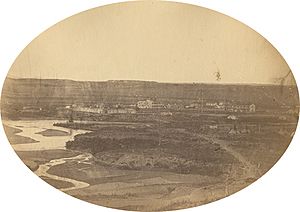
After the Army took over, Fort Laramie became a busy military base. Soldiers were there to help and protect the thousands of people traveling through. In 1851, an important agreement called the Treaty of Fort Laramie was signed here. This treaty aimed to create peace between the US government and several Native American tribes.
Even with the treaty, there were still some conflicts. The fort became more important for military actions in the 1860s. However, Fort Laramie itself was never attacked by Native American groups.
Buildings at Fort Laramie
When the Army bought Fort Laramie, they built many new structures. It was hard to build because of cold winters and a lack of materials. So, they often used adobe bricks, which were cheaper and good for insulation.
- Old Bedlam: Built in 1849, this is the oldest military building in Wyoming. It was where officers lived.
- Post Traders Store: Also built in 1849, this store sold supplies to soldiers, Native Americans, and pioneers. It grew over the years, even adding a bar for officers.
- Hospital: The first hospital was built in 1856 with adobe bricks. It had two rooms with eight beds each. A new, larger hospital was built in 1871.
- Housing: Other buildings were constructed for soldiers and their families. The Captains Quarters (1868-1870) and the Cavalry Barracks (1872-1874) are examples. The Cavalry Barracks is the only one left and could hold about 120 soldiers.
- Guardhouses: Two guardhouses were built. The Old Guardhouse (1866) could hold up to 40 prisoners. The New Guardhouse (1876) was built to help with overcrowding.
Many of the original buildings are now ruins, but about a third of them still stand today.
Fort Laramie During the Civil War
When the American Civil War started in 1861, many soldiers at Fort Laramie were sent east to fight. Volunteer soldiers, including some former Confederate prisoners who joined the Union Army, came to take their place.
Red Cloud's War and Other Conflicts
In the late 1860s, Fort Laramie was a main base during Red Cloud's War. This was a conflict between the US Army and the Sioux under Red Cloud. A famous event during this time was John "Portuguese" Phillips' horseback ride in 1866. He rode 236 miles through a blizzard to get help for another fort. In 1868, another Treaty of Fort Laramie was signed, bringing peace.
Later, in the 1870s, gold was found in the Black Hills. This led to more conflict with the Lakota and Northern Cheyenne during the Great Sioux War of 1876. Fort Laramie was a key place for sending supplies and troops during this war.
The Fort's Final Years
After the transcontinental railroad was finished, fewer people traveled west by wagon. The fort's importance slowly faded. In 1890, the Army decided to close Fort Laramie. Soldiers removed anything valuable, and the last troops left on April 20, 1890. Most of the buildings were sold to private citizens.
Fort Laramie Today
The US government bought the site back in 1938 to preserve it. It became the Fort Laramie National Monument and then the Fort Laramie National Historic Site in 1960. Today, you can visit the site and see 13 standing buildings, 11 standing ruins, and the foundations of many other structures. These remains help us understand the important history of Fort Laramie and the people who lived and traveled through this area.
See also
- List of the oldest buildings in Wyoming


